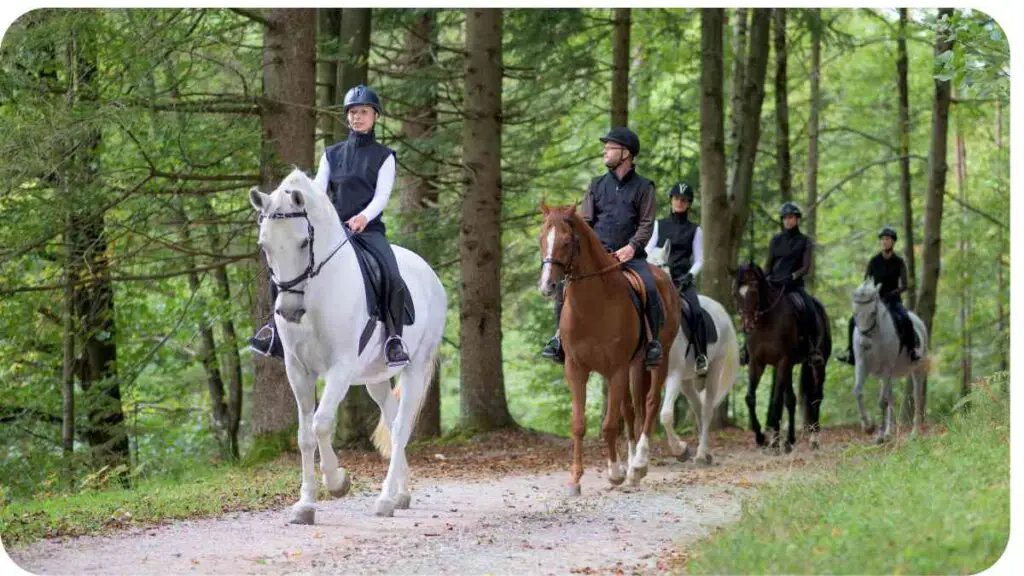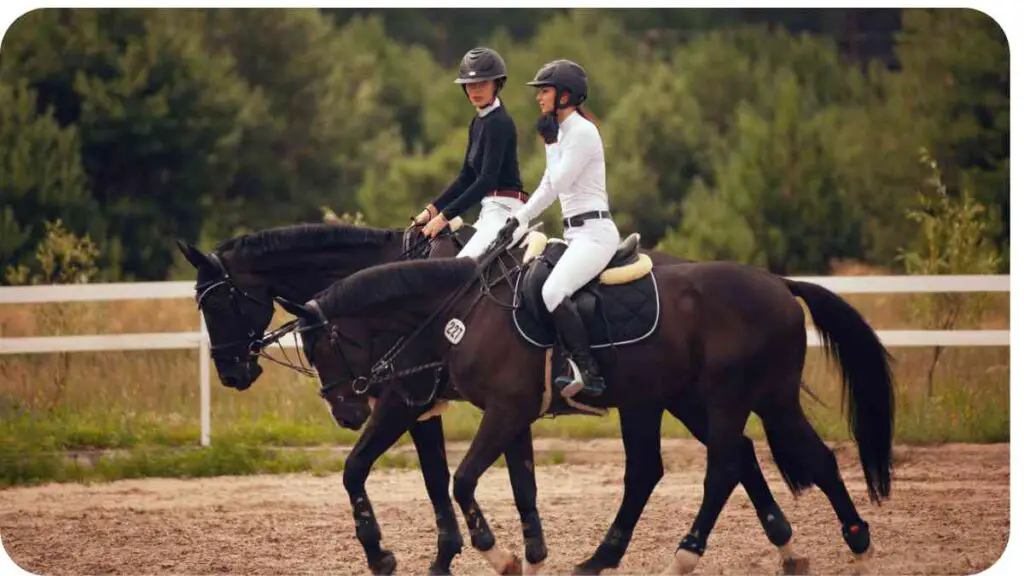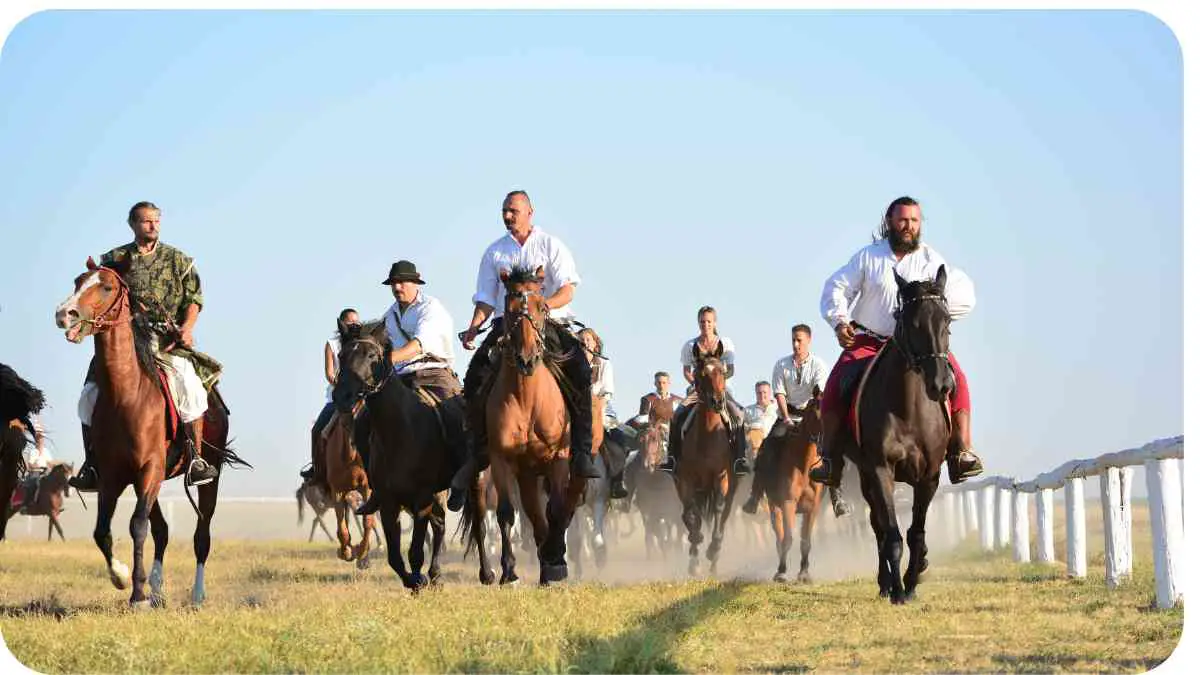Welcome to our comprehensive guide on horse riding etiquette! Whether you’re a seasoned equestrian or a novice rider, understanding the proper code of conduct while out on the trails is crucial for creating a safe and enjoyable riding experience for everyone involved.
In this article, we’ll delve into the importance of horse riding etiquette, from ensuring safety and courtesy towards others to preserving the environment. We’ll provide practical advice, share personal insights, and offer valuable tips to help you navigate various situations with finesse and confidence.
| Takeaways |
|---|
| Prioritize safety and respect when horseback riding on trails. |
| Follow proper trail riding etiquette to create a positive experience for all. |
| Be mindful of your surroundings and communicate effectively with fellow riders. |
| Leave no trace by properly disposing of waste and avoiding damage to the environment. |
| Show gratitude for a pleasant riding experience and maintain a supportive equestrian community. |
2. The Importance of Horse Riding Etiquette
Ensuring a positive experience for both riders and those they encounter on the trails involves considering safety, respect, and environmental consciousness.
When hitting the trails, remember that trail riding etiquette is essential for a pleasant experience. Learn more about trail riding etiquette and ensure everyone’s safety and enjoyment.
2.1 Safety Considerations
Prioritizing safety is paramount when engaging in any equestrian activity. By following proper horse riding etiquette, you’ll minimize the risk of accidents and create a secure environment for both equines and humans. Taking necessary precautions such as wearing appropriate safety gear and maintaining control over your horse are key elements to keep in mind.

2.2 Respect for Others
Respecting the rights and well-being of fellow riders, equestrians, hikers, and other trail users is central to horse riding etiquette. By demonstrating kindness, patience, and understanding, you contribute to a harmonious atmosphere that encourages positive interactions and maintains a sense of community.
2.3 Environmental Awareness
Preserving the natural beauty of the trails and minimizing the impact of horseback riding activities on the environment is essential. By practicing responsible riding habits and adhering to leave-no-trace principles, you help protect the delicate ecosystems and wildlife habitats that we are fortunate to explore.
Prioritize safety on your trail riding adventure with these valuable safety tips. Being prepared and informed will make your ride both safe and enjoyable.
3. Preparing for Your Ride
Before embarking on your trail adventure, it’s important to ensure that you have the necessary equipment and attire in order. This section provides guidance on the essential gear checklist and the appropriate dress code for horse riding.
3.1 Essential Gear Checklist
| Item | Purpose |
| Helmet | Protects your head during falls or impacts |
| Riding boots | Provides support and prevents foot slippage |
| Riding gloves | Offers grip and protects your hands |
| Riding breeches or jeans | Ensures comfort and mobility |
| Riding saddle | Provides a secure seat on your horse |
| Bridle and reins | Facilitates control over your horse |
| Grooming kit | Essential tools for grooming your horse |
3.2 Dress Code
| Recommended | Discouraged |
| Riding helmet | Loose clothing |
| Riding boots | Open-toed shoes |
| Long pants | Baggy clothing |
| Layered clothing for weather changes | Excessive jewelry |
| Comfortable and fitted attire |
Properly preparing yourself and your horse demonstrates your commitment to safety and sets the stage for a successful ride.
4. Trail Riding Etiquette
Heading out onto the trails requires adherence to a set of guidelines to maximize enjoyment for all trail users. Let’s explore the key aspects of trail riding etiquette.
Looking for the perfect trail riding destinations in the US? Explore the top ten most scenic spots in this guide to scenic trail riding destinations.
4.1 Riding Formation and Speed
Maintaining an appropriate riding formation and speed promotes safety and prevents trail congestion. Stick to a single file or follow the lead of an experienced trail guide if riding in a group. Avoid galloping or cantering on narrow or densely populated trails to minimize accidents.
4.2 Communication with Fellow Riders
Clear communication with fellow riders plays a crucial role in maintaining order and ensuring everyone’s safety. Use hand signals, vocal commands, or agreed-upon riding cues to coordinate movements, alert others of obstacles, or request assistance when needed. Stay attentive to both visual and verbal signals from your fellow riders.
4.3 Yielding to Other Trail Users
When encountering hikers, cyclists, or other non-equine users on the trail, practice proper yielding etiquette. Slow down or come to a complete
stop if necessary to allow them to pass safely. Communicate with a friendly greeting or nod to acknowledge their presence and make them aware of your approach. Always yield the right of way to pedestrians and those on foot.
“Before you head out on the trails, make sure you have the essential horseback riding equipment you need. From saddles to helmets, being well-prepared is key to a successful ride.
4.4 Leaving No Trace
Respecting the environment and leaving no trace of your presence is crucial for preserving the natural beauty of the trails. Dispose of any waste responsibly, including manure, by following designated waste management practices. Avoid straying from designated trails to prevent damaging sensitive ecosystems and habitats.
4.5 Managing Horse Behavior
Being aware of and managing your horse’s behavior is essential for a smooth and pleasant ride. Ensure that your horse is well-trained and responsive to your commands. Consider the temperament of your horse when planning trail rides and avoid overcrowded routes if necessary. Be considerate of other riders who may have horses that are easily spooked or require more space.
5. Interacting with Equestrians and Hikers

Respecting and maintaining positive interactions with fellow equestrians and hikers contributes to a supportive riding community. Here are some guidelines for interacting with others on the trail:
- If passing another equestrian, ask for permission and pass slowly and safely, leaving sufficient space between the horses.
- Greet other trail users with a friendly demeanor, such as a smile or nod.
- Avoid engaging in loud conversations or disruptive behavior that may disturb others’ experiences.
- Share knowledge and expertise when appropriate, but refrain from giving unwanted advice unless safety is at stake.
Creating a welcoming and friendly atmosphere fosters a sense of camaraderie among trail users and promotes overall enjoyment.
Don’t underestimate the importance of properly fitting horseback riding boots for a comfortable and safe trail riding experience. Learn how the right boots can enhance your ride.
6. Handling Encounters with Wildlife
Encountering wildlife while on the trails can be exhilarating. However, it’s crucial to remember that we are guests in their habitats. Follow these guidelines when interacting with wildlife:
- Observe wildlife from a distance to avoid disturbing or provoking them.
- Refrain from feeding or attempting to touch wild animals.
- Keep noise levels to a minimum to prevent startling wildlife.
- Stay on designated trails to minimize habitat disruption.
By respecting wildlife and their natural behavior, we can coexist harmoniously and appreciate the beauty of their presence.
7. Wrapping Up Your Ride
As your ride comes to an end, there are a few steps you can take to conclude on a positive note and leave a lasting impression of good horsemanship and trail etiquette.
7.1 Tacking Down and Cleaning Up
Take the time to properly tack down your horse, removing all equipment safely and with care. Groom your horse to remove any debris or sweat, ensuring their comfort and well-being. Clean up your own belongings and any waste that your horse may have left behind, maintaining the cleanliness of the trails for the next riders.
7.2 Expressing Gratitude
Expressing gratitude is a simple gesture that goes a long way in promoting positive interactions. Thank your fellow riders, trail guides, or anyone else who contributed to your enjoyable riding experience. It fosters a sense of community and appreciation within the equestrian world.
8. Conclusion
By following proper horse riding etiquette, you contribute to a safe, respectful, and enjoyable riding environment for all. Prioritizing safety, showing respect to fellow riders and trail users, and preserving the environment are essential aspects of being a responsible equestrian.
Remember to be mindful of your surroundings, communicate effectively with others, and leave no trace of your presence behind. By incorporating these principles into your riding routine, you enhance your own experience while setting a positive example for others.
Further Reading
For more information on horse riding etiquette and trail riding tips, check out the following resources:
- Trail Riding Etiquette for Horse Enthusiasts: This comprehensive document from Rutgers University provides valuable insights and guidelines for respectful trail riding, emphasizing safety and environmental considerations.
Description: This resource from Rutgers University offers a comprehensive guide on trail riding etiquette, focusing on safety and environmental awareness.
- Trail Riding Etiquette: A Guide for Horse Enthusiasts: The University of Kentucky’s College of Agriculture, Food, and Environment presents this resource that covers various aspects of trail riding etiquette, ensuring riders have a memorable and respectful experience on the trails.
Description: The University of Kentucky’s guide on trail riding etiquette provides horse enthusiasts with valuable tips and guidelines to enhance their trail riding experiences.
- Horse Trail Riding Tips: Equine Helper offers a collection of trail riding tips, including etiquette, safety considerations, and practical advice to make the most out of your trail adventures.
Description: Equine Helper provides a variety of trail riding tips that cover etiquette, safety, and other considerations to enhance your horse trail riding experiences.
FAQs
What should I wear for horseback riding?
For horseback riding, it is important to wear appropriate attire that includes long pants or riding breeches, riding boots with a heel, and a properly fitted helmet for safety.
How can I ensure the safety of myself and my horse while on the trails?
To ensure safety, always wear a helmet, maintain control over your horse, and follow proper riding formations and speed. Stay aware of your surroundings, communicate with fellow riders, and be prepared for unexpected situations.
How do I yield to other trail users?
When encountering hikers, cyclists, or pedestrians on the trail, slow down or stop to allow them to pass safely. Communicate with a friendly greeting or nod, yielding the right of way to non-equine users.
What should I do if my horse becomes spooked on the trail?
If your horse becomes spooked, try to stay calm and reassure your horse. Provide clear and consistent commands to regain control and consider finding a quiet area to regain composure before continuing the ride.
How do I leave no trace while trail riding?
To leave no trace, dispose of waste responsibly, stick to designated trails, and avoid straying from them. Respect and minimize your impact on the environment and wildlife habitats by following trail guidelines and practicing responsible riding habits.

Hi there! My name is Hellen James, and I’m a horse riding expert. I’ve been riding horses since I was just a kid—and it’s been my passion ever since. But getting started with horse riding can be overwhelming. There’s so much to learn! If you’re looking for a way to get started and make sure you’re doing it right, I’m here to help.


